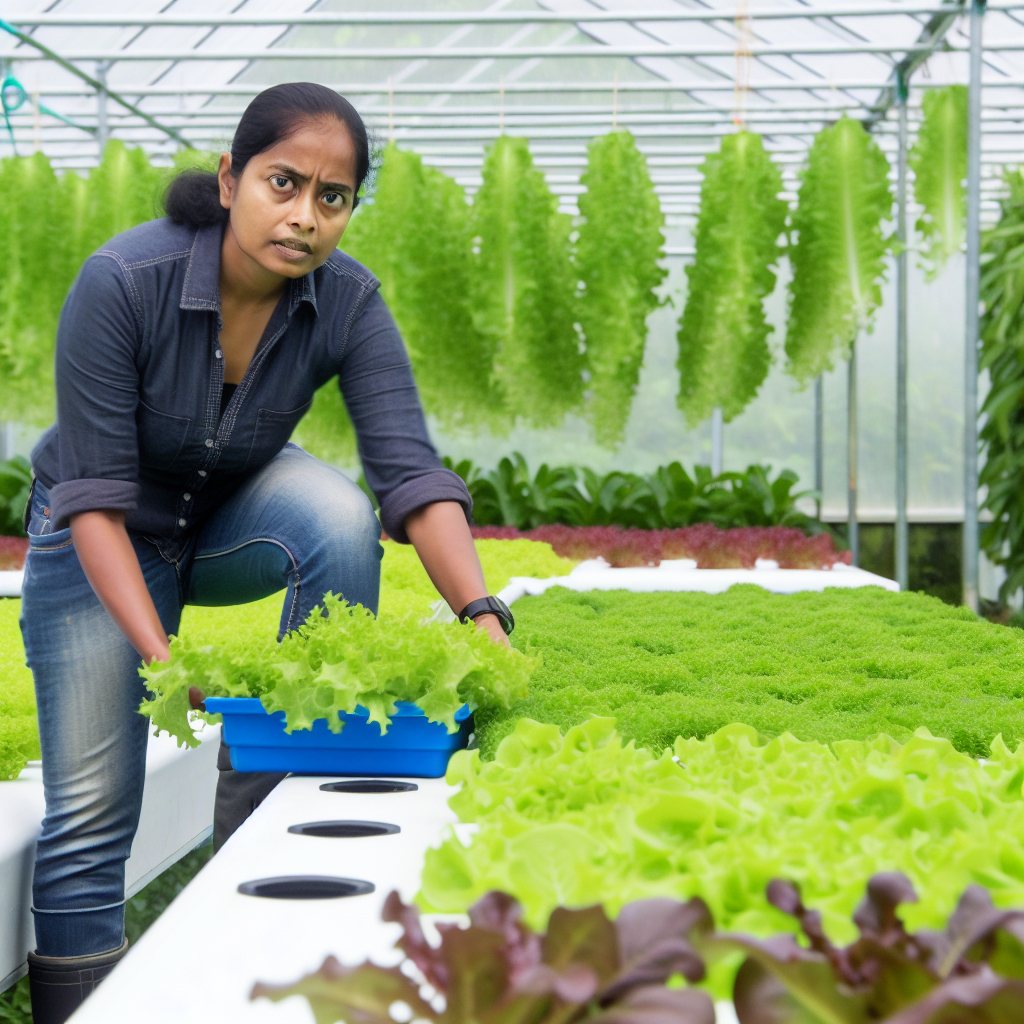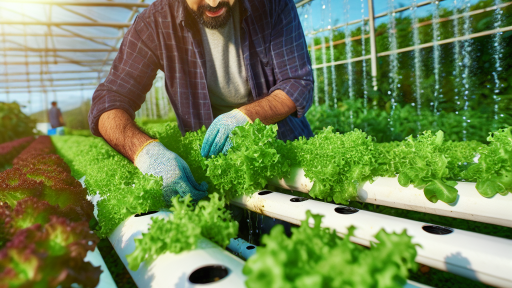Understanding Aquaponics
Definition of Aquaponics
Aquaponics combines aquaculture and hydroponics.
It creates a sustainable ecosystem for growing plants and fish.
The fish waste provides essential nutrients for the plants.
In return, the plants help purify the water for the fish.
This symbiotic relationship promotes efficient resource use.
Benefits of Aquaponics
Aquaponics offers numerous environmental benefits.
It conserves water compared to traditional farming practices.
This method encourages organic food production without synthetic fertilizers.
Additionally, it minimizes the need for pesticides.
Aquaponics systems can be set up in various locations.
Cost-Effectiveness
Initially, aquaponics can require a significant investment.
However, it often yields a high return on investment.
Over time, the systems can produce fresh food at lower costs.
This economic efficiency attracts many urban farmers.
Health Benefits
Aquaponically grown food tends to be fresher and tastier.
Transform Your Agribusiness
Unlock your farm's potential with expert advice tailored to your needs. Get actionable steps that drive real results.
Get StartedMoreover, it typically contains more nutrients than conventionally grown produce.
This method fosters a greater awareness of sustainable practices.
Ultimately, it encourages healthier eating habits among consumers.
Choosing the Right Location for Your Aquaponic System
Importance of Location
The location of your aquaponic system significantly impacts its success.
Good placement ensures optimal growth for plants and fish.
Additionally, the right location enhances ease of access for maintenance.
Sunlight Exposure
Consider the amount of sunlight your system will receive.
Most plants require at least six hours of direct sunlight daily.
If possible, choose a location with south-facing exposure.
This position maximizes light capture and promotes healthy growth.
Protection from Environmental Elements
Shield your system from harsh weather conditions.
Look for areas that offer natural windbreaks or shelter.
This protection minimizes stress on both plants and fish.
Furthermore, avoid locations prone to flooding or standing water.
Water Access and Quality
Ensure that your chosen site has easy access to water sources.
Aquaponics relies on a steady and clean water supply.
Test local water quality before setting up your system.
Consider any necessary filtration or treatment options.
Space and Area Considerations
Your location must have enough space for the full setup.
Plan for future expansions as your system grows and evolves.
Think about layout and design to utilize the space effectively.
Utilities and Resources
Check for nearby power sources to run pumps and lights.
Consider your need for nearby storage for supplies.
A reliable internet connection could also prove helpful.
Showcase Your Farming Business
Publish your professional farming services profile on our blog for a one-time fee of $200 and reach a dedicated audience of farmers and agribusiness owners.
Publish Your ProfileRegulatory and Zoning Considerations
Research zoning laws and local regulations before setting up.
Some areas have specific restrictions regarding aquaponics.
Contact your local agricultural extension office for clarification.
Community and Aesthetic Factors
Think about how your system will fit into your community.
Choose a location that is visually appealing and welcoming.
Community acceptance can enhance your overall experience.
Selecting the Best Fish and Plant Combinations
Understanding Compatibility
Choosing the right fish and plants is crucial for a successful aquaponic system.
Fish and plants have specific needs for nutrients and water conditions.
Compatibility ensures both thrive in a shared environment.
Popular Fish Choices
Certain fish adapt well to aquaponics and can boost your system’s efficiency.
Tilapia is a popular choice due to its hardiness and fast growth.
Trout requires cooler water, making it suitable for specific climates.
Koi offers aesthetic value and can help manage algae.
Beta fish, though small, can coexist with various plants in home setups.
Plant Selection
Plants in aquaponics must complement fish waste as a nutrient source.
Leafy greens like lettuce and spinach flourish in such environments.
Herbs such as basil and mint also thrive and enhance culinary experiences.
Root vegetables like carrots and radishes require careful planning in installation.
Creating a Balanced Ecosystem
A successful aquaponics system relies on a balanced ecosystem.
Monitor water quality for pH and nutrient levels regularly.
Rotate crops to maintain soil health and prevent pests.
Additionally, consider seasonal changes in plant selection.
Testing Combinations
Always start with small pilot combinations before expanding.
Observe growth and compatibility over several weeks.
Adjust parameters based on feedback and results.
Document successes and challenges for future reference.
Gain More Insights: Best Plants for Hydroponic Systems
Essential Components of an Aquaponic System
Fish Tank
The fish tank serves as the heart of the aquaponic system.
Here, fish thrive while providing nutrient-rich waste.
Common fish options include tilapia, catfish, or goldfish.
Each type of fish has specific care requirements.
Grow Bed
The grow bed accommodates plants that utilize fish waste.
Plants such as lettuce, herbs, and tomatoes flourish in this setup.
Choose a grow bed that allows for optimal drainage and aeration.
Pumping System
A reliable pumping system circulates water between fish and plants.
This ensures the plants receive nutrients from fish waste.
Solar or electric pumps can effectively manage this task.
Filtration System
A filtration system maintains water quality for both fish and plants.
This component removes solid waste while promoting beneficial bacteria.
Consider using a combination of mechanical and biological filters.
Showcase Your Farming Business
Publish your professional farming services profile on our blog for a one-time fee of $200 and reach a dedicated audience of farmers and agribusiness owners.
Publish Your ProfileWater Quality Monitoring Tools
Water quality monitoring tools are essential for a balanced ecosystem.
Using pH, ammonia, and nitrate test kits ensures system health.
Regular testing helps prevent toxic build-up that could harm fish.
Grow Lights (if indoors)
Grow lights are vital when natural sunlight is insufficient.
LED grow lights provide the necessary spectrum for plant growth.
Position lights to maximize exposure for all plants.
Find Out More: Harvesting Techniques For Container-Grown Plants
Building Your Aquaponic System: Step-by-Step Guide
Gather Essential Materials
Start by collecting all necessary components for your aquaponic system.
You will need a fish tank, grow beds, and a pump.
Include a filtration system to maintain clean water.
Additionally, have some growing medium like gravel or clay pellets on hand.
Select the Right Location
Choose a spot that receives ample sunlight throughout the day.
Ensure the area is free from debris and any potential contaminants.
Moreover, proximity to a power source is essential for the pump.
Set Up the Fish Tank
Start by positioning your fish tank in the selected location.
Check for any leaks before adding water.
Fill the tank with dechlorinated water to improve fish health.
Install the Grow Beds
Next, install the grow beds above the fish tank if using a media-based system.
Ensure they are sturdy and well-supported.
Connect the grow beds to the tank with appropriate plumbing.
Integrate the Pump and Filtration System
Install the pump inside the fish tank, ensuring it fits securely.
Connect the pump to the grow beds through the plumbing setup.
Set up a filtration system to remove waste from the water.
Add Growing Medium and Plants
Fill the grow beds with your chosen growing medium.
Next, transplant your selected plants into the grow beds.
Ensure that the roots have ample contact with the medium for nutrient uptake.
Introduce Fish into the Tank
After setting up, it’s time to add fish to the tank.
Choose fish that thrive in aquaponic systems, such as tilapia or goldfish.
Introduce them gradually to reduce stress and promote health.
Monitor Your System Regularly
Keep a close eye on water quality to ensure optimal conditions.
Test for pH levels, ammonia, and nitrate concentrations regularly.
Additionally, observe plant growth and fish behavior for signs of issues.
Adjust and Optimize as Needed
Be prepared to make adjustments based on test results.
For example, add nutrients if your plants show deficiencies.
Additionally, improve aeration if fish appear stressed.
Explore Further: Scaling Your Hydroponic Farm Successfully
Managing Water Quality and Nutrient Levels
Importance of Water Quality
Water quality plays a crucial role in aquaponics.
Healthy fish require clean, oxygen-rich water.
Furthermore, plants thrive in balanced environments.
Testing Water Parameters
Regular testing will help you maintain optimal conditions.
Showcase Your Farming Business
Publish your professional farming services profile on our blog for a one-time fee of $200 and reach a dedicated audience of farmers and agribusiness owners.
Publish Your ProfileTest for pH, ammonia, nitrites, and nitrates frequently.
You can use test strips or liquid kits for accuracy.
pH Levels
Most aquaponic systems thrive at a pH of 6.5 to 7.5.
Adjusting pH can involve adding acids or bases.
Ammonia and Nitrite Levels
Ammonia levels should stay below 1 ppm.
Nitrites must also remain low to ensure fish health.
Nitrate Levels
Nitrates serve as essential nutrients for plants.
Keep nitrate levels between 20 to 40 ppm for best growth.
Water Temperature
Monitor your system’s water temperature consistently.
Most fish prefer temperatures from 75°F to 80°F.
Maintaining Nutrient Levels
Nutrient levels directly impact plant productivity.
Fish waste provides nutrients, but you may need supplementation.
Supplemental Nutrients
Common supplements include iron, potassium, and calcium.
Use organic options to maintain system health.
Monitoring Plant Growth
Observe plant growth rates to assess nutrient levels.
Yellowing leaves may indicate nutrient deficiencies.
Recirculating Water Systems
Ensure your system circulates water efficiently.
Pumps should maintain flow rates suitable for both fish and plants.
Managing Waste and Filtration
Keep your filtration systems clean to promote water quality.
Consider mechanical and biological filters for efficiency.
You Might Also Like: Integrating Fruit Trees in Small Farms

Maintaining Your Aquaponic System for Optimal Performance
Regular Monitoring
Regular monitoring is essential for a successful aquaponic system.
Check water quality parameters weekly.
This includes pH, ammonia, nitrites, and nitrates levels.
Keep an eye on fish health and behavior as well.
Healthy fish signal a well-functioning system.
Water Quality Management
Good water quality is crucial for plant growth.
Maintaining the correct pH level ensures nutrient availability.
A pH between 6.8 and 7.2 is ideal for most plants.
Change 10% to 15% of the water stock every two weeks.
This practice helps remove accumulated toxins.
Nutrient Balance
Nutrient balance supports vigorous plant growth.
Monitor nutrient levels regularly.
Nitrogen is particularly important for leafy greens.
Supplement with organic fertilizers if necessary.
Consider adding seaweed extract to enhance growth.
Fish Care
Healthy fish are a vital part of your aquaponic ecosystem.
Feed them high-quality, balanced feed daily.
Observe your fish for signs of stress or disease.
Showcase Your Farming Business
Publish your professional farming services profile on our blog for a one-time fee of $200 and reach a dedicated audience of farmers and agribusiness owners.
Publish Your ProfilePerform routine water changes to maintain their habitat.
Keep the fish tanks clean to provide a healthy environment.
Pest and Disease Management
Prevent pests to ensure plant health.
Use beneficial insects to manage unwanted pests.
Consider integrated pest management techniques.
Maintain a clean growing environment to minimize disease.
Regularly inspect plants for any signs of infection.
Light and Temperature Control
Proper lighting enhances photosynthesis.
Ensure your plants receive 12 to 16 hours of light daily.
Monitor room temperature for ideal plant growth.
Maintain temperatures between 68°F and 78°F.
Adjust grow lights and temperatures as needed throughout the seasons.
System Maintenance and Cleaning
Regular maintenance prevents system failure.
Clean filters once a month to avoid blockages.
Inspect water pumps and aerators regularly.
Replace any worn components immediately.
Keep a maintenance log for all system checks and repairs.
Harvesting Techniques
Harvesting at the right time maximizes yield.
Monitor your plants closely for optimal harvest signs.
Use sterilized tools to avoid contamination.
Cut plants gently to encourage new growth.
Keep the fish tank undisturbed during harvesting.
Troubleshooting Common Issues in Aquaponics
Identifying Water Quality Problems
Water quality is crucial for a successful aquaponic system.
Start by testing pH levels regularly.
Ideal pH levels generally range from 6.8 to 7.4.
Monitor ammonia, nitrites, and nitrates closely.
High levels of these substances can harm your fish and plants.
Adjustments may involve adding buffering agents or water changes.
Dealing with Fish Health Issues
Fish health is a major concern in aquaponics.
Look for signs of stress or disease in your fish.
Symptoms may include abnormal swimming or discoloration.
Ensure that water conditions are optimal to reduce stress.
Maintain a consistent feeding schedule and proper nutrition.
Addressing Plant Growth Problems
Plant issues can arise in aquaponic systems, affecting yield.
Poor growth may result from inadequate nutrients.
Consider using mineral supplements for nutrient balance.
Ensure your plants receive sufficient sunlight or grow lights.
Inspect for pests that can hinder plant development.
Preventing System Failures
System failures can disrupt your aquaponic balance.
Perform routine checks on pumps and filtration systems.
Showcase Your Farming Business
Publish your professional farming services profile on our blog for a one-time fee of $200 and reach a dedicated audience of farmers and agribusiness owners.
Publish Your ProfileClogged filters can lead to decreased water flow.
Keep backups for essential equipment like water pumps.
Regular maintenance will keep your system running smoothly.
Mitigating Environmental Factors
Environmental factors can significantly affect your aquaponic setup.
Weather conditions may impact temperature and light exposure.
Use shade cloth or greenhouses to control light and temperature.
Monitor humidity levels, especially in indoor systems.
Adapting to these factors helps maintain stability.
Scaling Up: Expanding Your Aquaponic System for Larger Production
Assessing Your Current System
Start by evaluating your existing aquaponic setup.
Identify the strengths and weaknesses of your system.
This will inform your expansion decisions.
Setting Goals for Scale
Establish clear production goals for your expanded system.
Consider the types of fish and plants you want to grow.
Additionally, analyze your market and demand trends.
Choosing the Right Equipment
Investing in suitable equipment is essential for scaling.
Look for larger tanks and upgraded filtration systems.
Consider adding more grow beds to increase plant capacity.
Research options for automated controls to manage your system.
Designing for Efficiency
Your system layout should maximize efficiency and yield.
Utilize vertical growing techniques to save space.
Implement a layout that allows easy access for maintenance.
Ensure proper water circulation throughout your setup.
Integrating Advanced Techniques
Explore advanced farming techniques for greater productivity.
You may consider employing hydroponics within your system.
Incorporating nutrient cycling can enhance overall health.
Also, look into beneficial bacteria to boost nutrient availability.
Monitoring and Adaptation
Set up a robust monitoring system for optimal performance.
Track water quality, plant health, and fish growth regularly.
Adapt your techniques based on these observations.
Be prepared to modify your system as conditions change.
Building a Support Network
Connect with other aquaponic farmers for shared knowledge.
Join forums or local clubs to learn and exchange ideas.
Networking can provide support as you scale your system.
Investing in Education and Resources
Continuous learning is key to successful expansion.
Consider workshops or online courses to enhance your skills.
Stay updated with the latest research and trends in aquaponics.
Use available resources to strengthen your system’s effectiveness.




